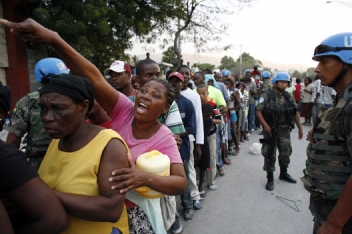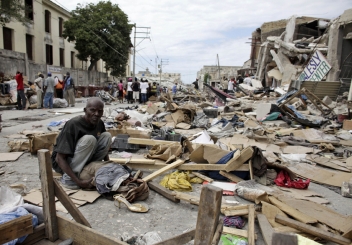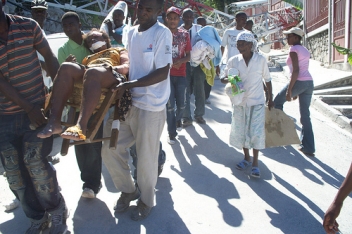Relief is slowly reaching the victims of the quake, 4 days after the quake. Rescue teams are searching for survivors under the rubbles. The people at the camps still looked patient.
 Several women were already busy setting up their open air restaurant serving the campers. Tire repairmen were also busy. The streets are filling up with cars. Gas stations are packed with motorcycles and vehicles trying desperately to get some gas. Grocery stores are opening their doors half way and allowing people to come in one by one to buy groceries. Relief workers are getting busy to assist people.
Several women were already busy setting up their open air restaurant serving the campers. Tire repairmen were also busy. The streets are filling up with cars. Gas stations are packed with motorcycles and vehicles trying desperately to get some gas. Grocery stores are opening their doors half way and allowing people to come in one by one to buy groceries. Relief workers are getting busy to assist people.
Helicopters are flying around, probably looking for pockets of victims or damaged buildings. A lot of people are working with masks around fearing that they may get infected from smelling the cadavers. Port-au-Prince, is trying to get busy again. It’s not going to be easy! In the meantime we are now hearing that other towns such as Jacmel, Leogane, Petit-Goâve, Vallee de Jacmel, Bainet and Cotes de Fer are also affected.
Worst-case scenario
It was the worst case scenario for Haiti, an earthquake hitting Port-Au-Prince. In fact, the density of the population (more than 2.5 million) the degradation of the mountains surrounding it, poor waste management, the anarchic construction, a weak governance and civil society made Port-au-Prince one of the most vulnerable capitals of the world.
An earthquake is unfortunately a natural phenomenon, and several scientists already predicted that it was a question of time before Haiti was hit. In fact it was long overdue. Haiti had a major earthquake every 100 years and we have not had one for more than 150 years.
Thousands of casualties
 So, the first estimates put the number of casualties to 50,000 people. Less conservative estimates say that as many as 200,000 people will have perished from the earthquake. Port-au-Prince with the precarious houses in the slums, and its bigger buildings not built to withstand hurricanes has been heavily hit.
So, the first estimates put the number of casualties to 50,000 people. Less conservative estimates say that as many as 200,000 people will have perished from the earthquake. Port-au-Prince with the precarious houses in the slums, and its bigger buildings not built to withstand hurricanes has been heavily hit.
However, it’s important to remember other towns that have been hit as well (Leogane, destroyed at 80% according to the United Nations, Jacmel, Vallée de Jacmel, Petit-Goâve, Bainet and Cotes-de-Fer.
It is said that at least 3.5 millions people have been affected directly or indirectly by this tragedy. Many stores owned by the wealthy elite of Haiti have collapsed. Many houses that they rent to middle class families have been destroyed. Many of the few professionals that were still working in Haiti have lost their lives. (One catholic archbishop, two senators, one high justice official, many university students perished in the tragedy).
Those who are still alive will not think long before deciding to migrate to other countries. As we know it, before the quake, many Haitians have already decided to migrate to the United States Canada and other countries.
Moreover, many of the people who died in Port-au-Prince were working to send money back home to their loved ones in the provinces. Haiti had a 80% unemployment rate. These people in the provinces are left without any source of income now.
They are mostly older people who cannot work the land anymore and who are not receiving any social assistance, pension funds from the government. They are also children who will have more difficulty to go to school.
Haiti will get back on its feet
 There is a proverb in Haiti that says, “When it’s darker, it’s a sign that daybreak is around the corner”. Given the tremendous solidarity that Haiti is enjoying now, the resilience of its people and the determination of a lot of goodwill people who still believe that Haiti will stand back on its feet, even in this time of uncertainty, there are tremendous opportunities to seize.
There is a proverb in Haiti that says, “When it’s darker, it’s a sign that daybreak is around the corner”. Given the tremendous solidarity that Haiti is enjoying now, the resilience of its people and the determination of a lot of goodwill people who still believe that Haiti will stand back on its feet, even in this time of uncertainty, there are tremendous opportunities to seize.
After the first few days of immediate relief, I think the improvised camps that are in Port-au-Prince should be moved to the provinces. If the relief agencies continue to provide assistance in Port-au-Prince, most of the people who have already gone back to their homes in the provinces will come back to Port-au-Prince.
Camps should be established in the major towns of Haiti, and the people at the camp in Port-au-Prince should be directed by bus to these camps to receive more assistance and in the recovery phase, they will welcome opportunities to do something to develop their own area and earn some money doing it.
Of course relief supplies or better yet cash can be sent to those who are already back to their rural towns. The cash will stimulate the local economy and will ease the pressure on them to come back to Port-au-Prince to look for small jobs and reinstate the conditions that would cause them to perish in another earthquake or natural disaster such as flood.
We will find and support older people
I would like to welcome my HelpAge International colleagues from the United Kingdom and Jamaica. Together, we are going to put up a team to work with our partners in order assist the victims and more importantly the older people, a category that can get left behind and forgotten in a catastrophe of that magnitude.
We will find these older people to let them know they are not alone as they will take care of their orphaned grandchildren and deal with the trauma of having lost their loved ones to a natural disaster they have never experienced before in their lives. We know that this work is for the short, medium and long term.
Read more about HelpAge’s work in Haiti.
